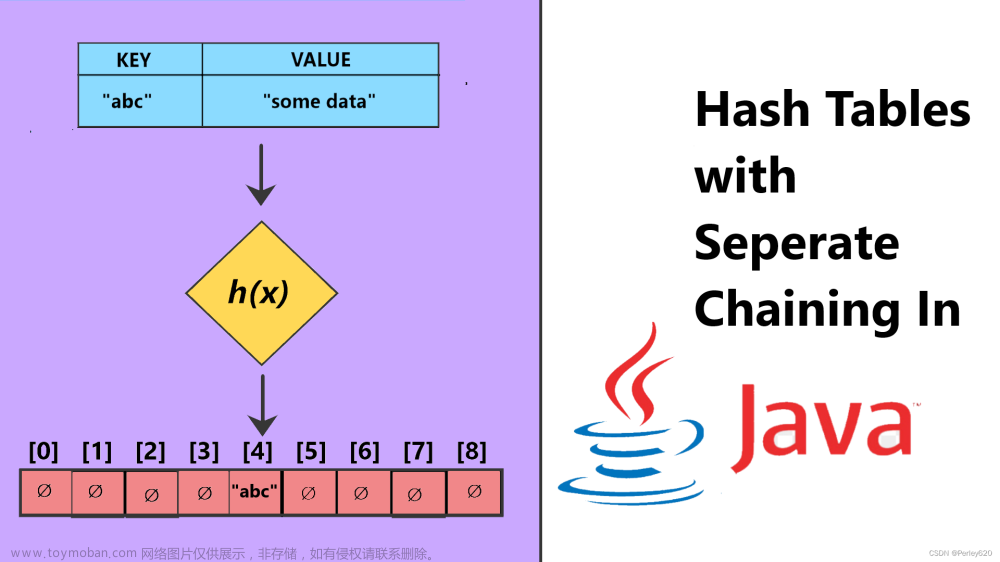目录
一、开散列的概念
1.1开散列与闭散列比较
二、开散列/哈希桶的实现
2.1开散列实现
哈希函数的模板构造
哈希表节点构造
开散列增容
插入数据
2.2代码实现
一、开散列的概念
开散列法又叫链地址法(开链法),首先对关键码集合用散列函数计算散列地址,具有相同地址的关键码归于同一子集合,每一个子集合称为一个桶,各个桶中的元素通过一个单链表链接起来,各链表的头结点存储在哈希表中。

从上图可以看出,开散列中每个桶中放的都是发生哈希冲突的元素。
1.1开散列与闭散列比较
应用链地址法处理溢出,需要增设链接指针,似乎增加了存储开销。事实上: 由于开地址法必须保持大量的空闲空间以确保搜索效率,如二次探查法要求装载因子a <= 0.7,而表项所占空间又比指针大的多,所以使用链地址法反而比开地址法节省存储空间。
二、开散列/哈希桶的实现
2.1开散列实现
哈希函数的模板构造
当数据类型不是整数时,我们需要通过哈希函数将其转换为一个size_t类型的无符号整形然后%上哈希表的容量得出一个映射值,所以需要针对不同的数据类型,来构造不同的Hashfunc来将其转换为size_t类型,这时就要用到模板特化来处理数据,尤其是字符串类型。
哈希表节点构造
同时针对set和map的不同,我们需要将hash桶的模板可以满足两种不同类型的调用,所以在参数上也要设置两个参数,如果是set传参,就让两个参数都是K,如果是map传参,第一个参数是K,第二个参数则是pair<K,V>,而在构造哈希表的node时,不管是set还是map都只需要传第二个参数过去,而hashnode也只需要用一个template<class T>来进行接收就好,然后构造初始化出T _data和一个T* _next的指针来指向桶中下一个节点。
那为什么在传参时不直接只设置一个参数呢?因为在调用find时,需要传一个值进去查找,如果是set则直接查找,如果是map则需要取出hashnode中的first与之进行比较,所以必须设置两个模板参数。
开散列增容
桶的个数是一定的,随着元素的不断插入,每个桶中元素的个数不断增多,极端情况下,可能会导致一个桶中链表节点非常多,会影响的哈希表的性能,因此在一定条件下需要对哈希表进行增容,那该条件怎么确认呢?开散列最好的情况是:每个哈希桶中刚好挂一个节点,再继续插入元素时,每一次都会发生哈希冲突,因此,在元素个数刚好等于桶的个数时,可以给哈希表增容。文章来源:https://www.toymoban.com/news/detail-854563.html
插入数据
因为开散列每个位置都是一串单链表,所以在插入节点时,直接选择头插即可,头插的消耗和速度都是最小的。文章来源地址https://www.toymoban.com/news/detail-854563.html
2.2代码实现
#pragma once
#include<iostream>
using namespace std;
#include<vector>
#include<string>
template<class K>
struct HashFunc
{
size_t operator()(const K& key)
{
return (size_t)key;
}
};
// 特化
template<>
struct HashFunc<string>
{
size_t operator()(const string& s)
{
size_t hash = 0;
for (auto e : s)
{
hash += e;
hash *= 131;
}
return hash;
}
};
namespace hash_bucket
{
//如果是unordered_set的话T=K
//如果是unordered_map的话T=pair<K,V>
template<class T>
struct HashNode
{
HashNode<T>* _next;
T _data;
HashNode(const T& data)
:_next(nullptr)
,_data(data)
{}
};
// 前置声明,因为编译器编译时会向上进行查找,而iterator要去调用哈希表,所以需要提前进行前置声明
template<class K, class T, class Keyoft, class Hash >
class HashTable;
//迭代器实现
template<class K, class T, class Keyoft, class Hash >
struct __HTIterator
{
typedef HashNode<T> Node;
typedef HashTable<K, T, Keyoft, Hash> HT;
typedef __HTIterator<K, T, Keyoft, Hash> Self;
Node* _node;
HT* _ht;
__HTIterator(Node* node,HT* ht)
:_node(node)
,_ht(ht)
{}
T& operator*()
{
return _node->_data;
}
Self& operator++()
{
//如果当前桶内还有节点
if (_node->_next)
{
_node = _node->_next;
}
else
{
//当前桶找完,就去找下一个桶
Keyoft kot;
Hash hs;
size_t hashi = hs(kot(_node->_data)) % _ht->_tables.size();
hashi++;
while (hashi < _ht->_tables.size())
{
if (_ht->_tables[hashi])
{
_node = _ht->_tables[hashi];
break;
}
hashi++;
}
//如果后面没有桶
if (hashi == _ht->_tables.size())
{
_node = nullptr;
}
}
return *this;
}
bool operator!=(const Self& s)
{
return _node != s._node;
}
};
//哈希桶搭建
template<class K, class T,class Keyoft,class Hash>
class HashTable
{
template<class K, class T, class KeyOfT, class Hash>
friend struct __HTIterator;
typedef HashNode<T> Node;
public:
typedef __HTIterator< K, T, Keyoft, Hash> iterator;
HashTable()
{
_tables.resize(10, nullptr);
_n = 0;
}
~HashTable()
{
for (size_t i = 0; i < _tables.size(); i++)
{
Node* cur = _tables[i];
while (cur)
{
Node* next = cur->_next;
delete cur;
cur = next;
}
_tables[i] = nullptr;
}
}
iterator begin()
{
for (size_t i = 0; i < _tables.size(); i++)
{
// 找到第一个桶的第一个节点
if (_tables[i])
{
return iterator(_tables[i], this);
}
}
return end();
}
iterator end()
{
return iterator(nullptr, this);
}
//插入节点
bool insert(const T& data)
{
Keyoft kot;
if (Find(kot(data)))
return false;
Hash hs;
//负载因子到1就扩容
if (_n == _tables.size())
{
vector<Node*> newtables(_tables.size() * 2,nullptr);
for (size_t i = 0; i < _tables.size(); i++)
{
Node* cur = _tables[i];
while (cur)
{
Node* next = cur->_next;
//头插到新表
size_t hashi = hs(kot(cur->_data)) % newtables.size();
newtables[hashi] = cur;
cur = next;
}
_tables[i] = nullptr;
}
_tables.swap(newtables);
}
size_t hashi = hs(kot(data)) % _tables.size();
Node* newnode = new Node(data);
//头插
newnode->_next = _tables[hashi];
_tables[hashi] = newnode;
++_n;
return true;
}
//查找
Node* Find(const K& key)
{
Hash hs;
Keyoft kot;
size_t hashi = hs(key) % _tables.size();
Node* prev = nullptr;
Node* cur = _tables[hashi];
while (cur)
{
if (kot(cur->_data) == key)
return cur;
cur = cur->_next;
}
return nullptr;
}
Node* Erase(const K& key)
{
Hash hs;
Keyoft kot;
size_t hashi = hs(key) % _tables.size();
Node* prev = nullptr;
Node* cur = _tables[hashi];
while (cur)
{
if (kot(cur->_data) == key)
{
if (prev == nullptr)
{
_tables[hashi] = cur->next;
}
else
{
prev->_next = cur->_next;
}
}
prev = cur;
cur = cur->_next;
}
return false;
}
private:
vector<Node*> _tables;//指针数组
size_t _n;
};
}到了这里,关于C++王牌结构hash:哈希表开散列(哈希桶)的实现与应用的文章就介绍完了。如果您还想了解更多内容,请在右上角搜索TOY模板网以前的文章或继续浏览下面的相关文章,希望大家以后多多支持TOY模板网!














